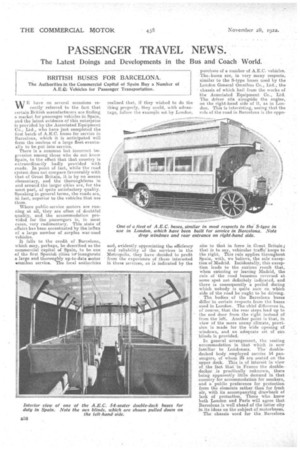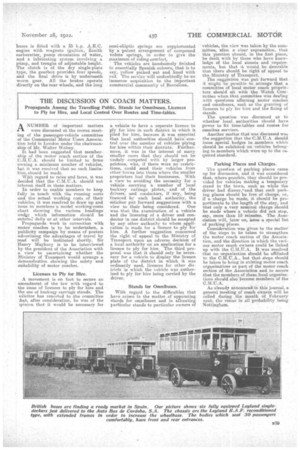PASSENGER TRAVEL NEWS.
Page 22

Page 23

If you've noticed an error in this article please click here to report it so we can fix it.
The Latest Doings and Developments in the Bus and Coach World.
BRITISH BUSES FOR BARCELONA.
The Authorities in the Commercial Capital of Spain Buy a Numbzr of A.E.C., Vehicles for Passenger Transportation.
WE have on several occasions recently referred to the fact that certain British manufacturers are finding a market for passenger vehicles in Spain, and the latest evidence of this enterprise is provided by the Associated Equipment Co., Ltd., who have lust completed the first batch of A.E.C. buses for serviee in Barcelona, which it is anticipated will form the nucleus of a large fleet eventualiy to be put into service. There is a common but incorrect impression among those who do not knew Spain, to the ffect that that country is extraordinarily badly provided with roads. In point of fact, while the road system does not compare favourably with that of Great Britain, it is by no means elementary, and the thoroughfares in and around the larger cities are, for the most part, of quite satisfactory quality. Speaking in general terms, the roads are, in fact, superior to the vehicles that use them.
Where public-service motors are running at all, they are often of doubtful quality, and the accommodation provided for the passengers is, in most cases, very rudimentary. This state of affairs has been accentuated by the influx of a large number of surplus war-used vehicles.
It falls to the credit of Barcelona, which may, perhaps, be described as the commercial capital of Spain, to be one of the first Spanish cities ter-inaugurate a large and thoroughly up-to-date motor omnibus service. The local authorities realized that, if they wished to do the thing properly, they could, with advantage, follow the example set by London,
and, evidently appreciating the efficiency and reliability of the services in the Metropolis, they have.. decided to profit from the experience of those interested in these services; AS is indicated by the
purchase of a number of A. E.G. vehicles. The buses are, in very many respects, similar to the S-type buses used by the London General Omnibus Co., Ltd.. the • chassis of which hail from the works of the Associated Equipment Co., Ltd. The driver sits alongside the engine, on the right-hand side of if, as in London. This is interelsting, seeing that the rule of the road in Barcelona is the oppo
site to that in force in Great Britain; that is to say, vehicular traffic-keeps to the right. This rule applies throughout Spain, with, we believe, the sole exception of Madrid. Incidentally, this exception leads to the curious result that, when entering or leaving Madrid, the rule of the road becomes reversed at some spot not definitely indicated, and there is consequently a peribd during which nobody is quite sure on which side of the road he ought to be driving.
The bodies of the Barcelona buses differ in certain respects from the buses used in London. The chief difference is, of course, that the rear steps lead up to the end door from the right instead of from the left. Another point is that, in view of the more sunny climate, provision is made for the wide opening of windows, and an adequate set of snit blinds is provided. In general arrangenient, the seating accommodation is that which is now
• familiar to Londoners. The doubledecked body employed carries 54 passengers, of whom 24 are .seated on the .upper deck. . This is of interest in view of the fact that in France the doubledecker is practically unknown, there being apparently little demand in that country for accommodation for smokers, and a public preference for protection from the elements rather than for fresh air, with its accompanying drawback of lack of protection. Those who. know both London and Paris will agree that Barcelona is well ahead of the latter city in its ideas on the subject of motorbuses.
The chassis used for the .Barcelona
buses is fitted with a 5 hp. A.E.C. engine with magneto ignition, Zenith carburetter, pinup oirculatiou of water, and a lubriCating system involving a pump, and troughs of adjustable height. The clutch is of the dry single-plate type; the gearbox provides four speeds, and the final drive is by underneath worm gear. All the brakes operate directly on the rear wheels, and the long
semi-elliptic springs are supplemented by a patent arrangement of compound volute springs, in order to give the maximum of riding comfort,
The vehicles are handsomely finished in essentially Spanish colours, that is to say, yellow picked out and lined with red. The service will undoubtedly be an immense -acquisition to the important commercial community of .Barcelona.




























